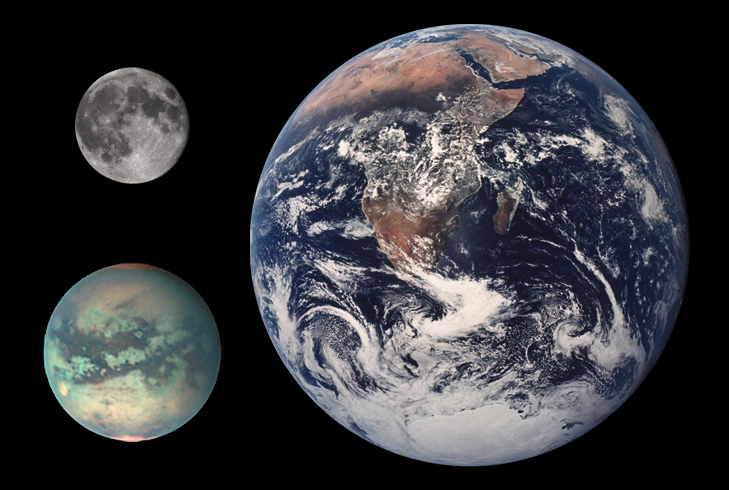Econintersect: The Cassini-Huygens spacecraft was launched 15 October 1997 and entered into orbit around Saturn 01 July 2004, where the Cassini part of the space probe remains today. Huygens, a robotic lander separated from Cassini in December 2004 and landed on the Saturn moon Titan 14 January 2005. The lander was named after Christiaan Huygens, the Dutch astronomer who first spotted the the moon in 1655. After all the years of data transmission back to earth, Cassini is in the news again because returned to earth one of the most distant images ever from space for the planet earth at 10:27 pm GMT 19 July 2013. More on that below after some review of Titan.
Click on image for larger view of NASA photo at The Christian Science Monitor.
Titan has lakes and rivers of liquid hydrocarbons, mostly methane and ethane.
Titan, The Largest Moon of Saturn
According to Wikipedia, Titan is primarily composed of water ice and rocky material. Here is detail of theWikipedia description of Saturn’s largest moon:
The atmosphere of Titan is largely composed of nitrogen; minor components lead to the formation of methane and ethane clouds and nitrogen-rich organic smog. The climate—including wind and rain—creates surface features similar to those of Earth, such as dunes, rivers, lakes and seas (probably of liquid methane and ethane), and deltas, and is dominated by seasonal weather patterns as on Earth. With its liquids (both surface and subsurface) and robust nitrogen atmosphere, Titan’s methane cycle is viewed as an analog to Earth’s water cycle, although at a much lower temperature.
This information detail was determined from data returned to earth by Huygens after its landing.
Titan is actually bigger by volume than the smallest planet Mercury, but less than half as dense. It has 50% more volume than our moon and has greater density with 80% more mass. The following picture from NASA (via Wikipedia) compares earth (largest body) and its moon (smallest body) with Titan.
Gravity on Titan is roughly the same as that of our moon (about 14% of earth) and the atmosphere is so thick (the temperature is 300 degrees F and more below zero) that humans could actually fly by moving arms an legs, akin to swimming. Of course an impressively insulated wet suit and self-contained breathing apparatus would be required because the 90% nitrogen atmosphere contains negligible amounts of oxygen.
Click on picture for larger image.
Picture of the Earth from Beyond Saturn
The picture of earth just taken is part of a more extensive activity which will create a panorama of Saturn and its rings back lit by the sun when the position of Cassini is such that Saturn “eclipses” the sun from the space probe vantage point. This has been done before (2006) and the mosaic composite shown below was created. This time was the last opportunity for such a picture before Cassini ends life with a fiery crash into Saturn in 2017.
The earth is visible in the above picture from 2006. In case you have trouble spotting it, it has been circled in red in the following copy of the picture above.
The earth seems pretty small at such a distance. This was not lost on Carl Sagan who narrated a video “Pale Blue Dot” after the first deep space photo of earth was taken from a much greater distance (4 billion miles) in 1990 by Voyager as it exited the solar system.
Any time you start to think about how important you are, return to view this video for a more realistic assessment.
Sources:
- Cassini Spacecraft Takes 1 Last Look at Home Today (Lee Billings, Scientific American, 19 July 2013)
- Cassini takes inter-planetary portrait. What happens next? (Karen Kaplan, Los Angeles Times, 19 July 2013)
- Titan (moon) (Wikipedia)
- File:Titan Earth Moon Comparison.png (Wikipedia)
- Titan: Exploring the origins of life (Michelle Thaller, The Christian Science Monitor, 12 December 2002)










